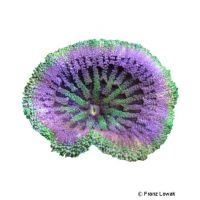Mini Carpet Anemone (Stichodactyla tapetum)
| Mini Carpet Anemone Stichodactyla tapetum | |
|---|---|
| Name | Mini Carpet Anemone |
| Name Lat. | Stichodactyla tapetum |
| Synonym | Discosoma tapetum |
| Family | Sea Anemones |
| Family lat. | Stichodactylidae |
| Order | Sea Anemones |
| Order lat. | Actiniaria |
| Origin | Indo-Pacific |
| Diet | Autotrophic, carnivore |
| pH | 8.1-8.4 |
| Hardness | 8-12 °KH |
| Lighting | High |
| Current | Moderate |
| Behavior | Semi-aggressive |
| Keeping | Individual |
| Care Level | Moderate |
| Life Span | N/A |
| Protection | No |
| Metric Units | |
| Size | 2-6 cm |
| Temperature | 24-28 °C |
| Salinity | 33-36 ‰ |
| Aquarium | 100 l |
| US Units | |
| Size | 1-2.4" |
| Temperature | 75-82 °F |
| Salinity | 1.020-1.025 sg |
| Aquarium | 25 gal |
Distribution and habitat
Stichodactyla tapetum are widely distributed from the Red Sea, the east coast of Africa, Indonesia, the Great Barrier Reef to southern Japan. They live solitary on reefs between coral blocks and in rock crevices in the shallow water zone.
Maintenance
They should be positioned in a very bright spot among fissured rock in medium, alternating flow by gently pressing them there for a short time.
Only substrates rich in lime and free of heavy metals should be used as substrate. To ensure water quality, filters, skimmers and heaters are necessary, as well as pumps to simulate tides, swells and bottom currents. It is recommended that live stones be used to set up the aquarium. The bacteria living in the porous stones act as a biological filter. The lighting must correspond to the species-appropriate day-night rhythm of the animals
| Salinity: 33-36 ‰ | pH value: 8.1-8.4 |
| Carbonate hardness: 8-12 °KH | Nitrate content: 2-8 mg/l |
| calcium content: 420-450 mg/l | Nitrite content: 0.0-0.05 mg/l |
| Magnesium content: 1.250-1.350 mg/l | phosphate content: 0.01-0.1 mg/l |
Regular addition of trace elements, especially iodine, is recommended. For salinity, an average value should be aimed for, which may only vary slightly by +/- 0.5 ‰. Ammonia and ammonium must not be measurable. Special attention shall be paid to consistently good water quality and water values.
Diet
Zooxanthellae, which are unicellular symbiotic algae, live in their tissue and provide them with assimilation products of their photosynthesis (high light requirement). The zooxanthellae promote growth and provide additional food to the plankton and small particles collected from the water current. Thus, in addition to the food produced in the aquarium during fish feeding (mysis, krill, Artemia, etc.), commercially available supplementary food in the form of phyto- and zooplankton should be offered regularly
Regular and varied feeding promotes health and prevents deficiency symptoms.
Behaviour and compatibility
This solitary anemone is not a symbiotic anemone of anemonefish, but is often inhabited by crabs and shrimp in nature. They should be kept together with Neopetrolisthes maculatus (spotted porcelain crab) or Periclimenes shrimp. Other animals that stick to their tentacles will be devoured. Sufficient distance must be maintained from other corals to avoid encrustation.
Reproduction and breeding
They are separately sexual. Their larvae are part of the plankton for several weeks until they settle in a suitable place. Reproduction by division is also possible, which often succeeds in the aquarium.
Important
After being placed in the aquarium, they sometimes wander until they find a suitable place themselves.
The partners living in symbiosis with it are very helpful in the sometimes difficult acclimation. Healthy animals have a closed oral disc and look "pumped up". Recommended for their growth (zooxanthellae) is supplementing lighting with Actinic light, a short wavelength violet-blue light. With their highly nettling and adhesive tentacles, skin contact is better avoided.
Newly introduced animals must be acclimated slowly to the water in the aquarium. If different species are kept together, care should be taken to ensure that fish and invertebrates match each other in terms of water quality and temperature requirements and social behavior, and that the setup meets the ecological needs of all species kept together
Further literature can be found in your pet store.
References
Text: Werner Winter; Image: Franz Lowak
Source: ENGELMANN & LANGE (2011): Zootierhaltung - Tiere in menschlicher Obhut: Wirbellose, Verlag Harri Deutsch
